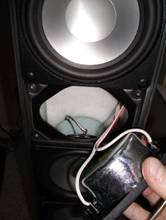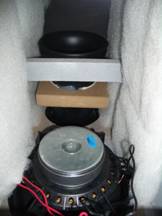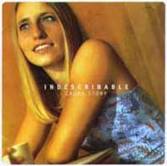Canton CD 300 Series Home Theater System
- Product Name: CD 300 Series
- Manufacturer: Canton
- Performance Rating:




- Value Rating:




- Review Date: March 29, 2005 19:00
- MSRP: $ 5400
CD 300
Floorstanding speaker - $2,000/pr
Engineering Principle: 2½-way
Bass reflex system
Nom. /Music power handling: 110 / 170 watts
Frequency
response: 30 Hz - 30 kHz
Crossover frequency: 400 / 3.300 Hz
Woofer: 2 x
4" (110 mm) aluminum
Midrange: 2 x 4" (110 mm aluminum
Tweeter: 1 x 1" (25
mm) aluminum
Nominal impedance: 4-8 ohms
Dimensions: 4.8'' x 47.2'' x
6.3'' (12.3 x 120 x 16 cm
Weight: 26.4 lbs (12 kg)
Enclosure finish:
brushed aluminum silver
Cover: Silver metal grill
Special features:
Magnetically shielded, aluminum speaker base plate
Karat AS 200 SC Active Subwoofer -
$1000/ea
Engineering Principle: Bass reflex
system
Nominal/musical output: 140 / 200
watts
Frequency response: 22-150
Hz
Crossover frequency: 50-150 Hz
(adjustable)
Woofer 1 x 10" (260 mm)
Cellulose/graphite
Dimensions: 11.6'' x 17.7'' x
18.5'' (29.5 x 45 x 47 cm)
Weight: 50.6 lbs (23
kg)
Enclosure finishes: Lacquer graphite, cherry veneer, beech veneer, silver
lacquer
Special features: Downfiring woofer, magnetically shielded, adjustable
phase limiter, adjustable crossover frequency, adjustable bass level,
SC-technology
CD 360 F Flat
speaker - $800/ea
Engineering Principle: 2½-way closed
system
Nom. /Music power handling: 110 /
170 watts
Frequency response: 33 Hz - 30
kHz
Crossover frequency: 400 / 3.300
Hz
Woofer: 2 x 4" (110 mm)
aluminum
Midrange: 2 x 4" (110 mm)
aluminum
Tweeter: 1 x 1" (25 mm)
aluminum
Nominal impedance: 4-8
ohms
Dimensions: 4.8'' x 23.6'' x 3.9'' (12.3 x 60 x 10 cm)
Weight: 17.8
lbs (8.1 kg)
Enclosure finish: brushed aluminum
silver
Cover: Silver metal
grill
Available accessories: Table top
stand TS 360 F
Special features:
Magnetically shielded, wall brackets included
Pros
- Excellent bass extension (with the AS 200 SC)
- Clean highs without overabundant sibilance
- Can play fairly loud
- Beautiful, elegant design with high appeal
Cons
- Noticeable off-axis frequency dip
- Missing a bit of air on the top end
- Subwoofer not as tight at high SPLs
- Pricey
Canton CD 300 Series Overview
With the new trend towards flat panel displays and silver colored electronics (at least for televisions) it is no wonder several manufacturers are releasing space-saving loudspeaker designs custom-tailored for the person living with 21st century technology. We previously reviewed Canton 's Karat Reference Series loudspeakers and found them to be competitive performers for their price. Now it was time to see if this German company could mesh form with function and not leave us wanting for more.
We found the Canton CD 300 Series speakers to be incredibly attractive and rather solidly constructed - likely due to their brushed aluminum silver enclosures. Considering that the drivers are also aluminum, you've got a lot of metal packed into these speakers and their size belies their weight. The two CD 300 floorstanding loudspeakers come shipped in pairs in a single large box. The center and surrounds were the venerable CD 360 F loudspeakers, which, in addition to being incredibly flexible are a near perfect timbral match to the CD 300. The subwoofer that was provided for review was the Karat AS 200 SC, a 10" down-firing subwoofer that reportedly extends to 22Hz yet maintains a relatively small footprint.
Canton CD 300 Series Build Quality & Unpacking
 To begin, we unboxed the system and
noted that the speakers were well-packed in Styrofoam with sheets of soft cloth that protected the
finish of each speaker on both sides. In addition, Canton supplies wall brackets for flush mounting the
CD 360 F loudspeakers to the wall. This is nice considering that for most companies this would be, at
best, another expense or, at worst, a Frankenstein aftermarket part. The aluminum speaker bases for the
CD 300 towers are separate from the tower and screw on via three Philips head machine screws. The bases
are even indented so there's no way to misalign the loudspeakers in the stands. Each stand has a hole
in the base, allowing you to unobtrusively run a small gauge cable through it and further hide system
cabling. As these speakers were going back following the review, we placed the surrounds on speaker
stands rather than wall-mounting them.
To begin, we unboxed the system and
noted that the speakers were well-packed in Styrofoam with sheets of soft cloth that protected the
finish of each speaker on both sides. In addition, Canton supplies wall brackets for flush mounting the
CD 360 F loudspeakers to the wall. This is nice considering that for most companies this would be, at
best, another expense or, at worst, a Frankenstein aftermarket part. The aluminum speaker bases for the
CD 300 towers are separate from the tower and screw on via three Philips head machine screws. The bases
are even indented so there's no way to misalign the loudspeakers in the stands. Each stand has a hole
in the base, allowing you to unobtrusively run a small gauge cable through it and further hide system
cabling. As these speakers were going back following the review, we placed the surrounds on speaker
stands rather than wall-mounting them.
The center channel is also a CD 360 F and identical to the surrounds. Placing it on its side allows it to function as a horizontally-oriented speaker. We found it quite thoughtful that Canton includes an extra backing clip so that logo pendant on the surrounds could be rotated 90 degrees in order to re-orient it for a vertical speaker presentation. They are shipped in the correct orientation for the center channel. Another thing to note is that you'll likely want to order the TS 360 F table top stand if you are using the CD 360 F in this manner. Setting the speaker on its side by itself will not yield the best speaker position in most cases.
All speaker covers are silver metal grills and are quite easily removable. Simply slide a screwdriver or other flat object between the grill and case and gently pry the grill out. We liked the speakers with the grills on as well as off, but would suppose that since this system so favors an unobtrusive design, leaving the grills on would be the best option for aesthetics. Of course, if your television is black you might decide the opposite.
Build Quality
When you lift the CD 300 towers you will at once note their impressive weight and relative density. I wanted to take a look inside and see what Canton did with the enclosure and the drivers. As you can see in the accompanying picture, Canton used plenty of dampening material in the cabinets and the diameter of the motor structure on their 4" aluminum drivers are almost as big as the cones. Canton labels this a 2 1/2-way bass reflex system, meaning that each cabinet contains four 4" aluminum drivers and an aluminum-manganese ADT-25 dome tweeter. The top two drivers handle mid-range and bass while the bottom two, primarily handle bass frequencies. The idea is that this type of configuration will yield a much "bigger" sound from a smaller, narrower package. Canton claims that this design provides the equivalent surface area of a single 8" woofer, but in a narrower cabinet. If you do the math: Four 4" drivers = 4 x 2^2 x pi = 50.26" while one 8" driver = 4^2 x pi = 50.26" thus their claim is absolutely true. The CD 360 F speakers are a shorter but otherwise identical version of the CD 300 towers which also lack the front-firing flared port.The 4 mid-bass/bass drivers are a modified version of the 4" concave aluminum cones used in the Karat and Ergo lines. The difference is that the CD 300 Series needed to rework the motor structure in order to get the lower frequency response needed by the CD 300 and CD 360 F speakers. Each of the 4" drivers has a concave aluminum dust cap which Canton applies for reasons of better linearity and increased dispersion. The surrounds are formed from injected rubber and are quite sturdy, appearing to have longevity as a strong point.
The ADT-25 tweeter does something unusual in that it has a single structure for the dome and voice coil former to achieve better heat dispersion and avoid some of the problems with glued domes. Aside from heat benefits, the resulting structure also better maintains its shape during use and resists break up during high SPLs.
The AS 200 SC subwoofer surprised me with its performance considering its modest size. I wanted to peel it back and see just what was inside that yielded such a sizable response from a relatively small enclosure. Opening up the sub I was pleased to find that it was manufactured from 1" thick M DF and had some significant cross-bracing to stabilize the cabinet. In addition, there was ample dampening material to render the interior of the cabinet fairly inert. We were not surprised to see that the basket for the 10" cellulose/graphite driver was apparently made out of the same polycarbonate that we've seen before in Canton lines. They prefer this over aluminum or steel, claiming better stiffness across the entire operating range of the speaker and superior damping. The 140 Watt R M S amplifier, though not very powerful at this price range, seemed beefy enough to deliver the goods. The sub also featured adjustable level control, a variable 50 Hz - 150 Hz crossover and adjustable 0 - 180 degrees phase control. The AS 200 SC also features line level and speaker-level inputs and outputs.Canton CD 300 Series Setup and Listening Tests
 I set the CD 300 towers in front and began
with them toed slightly in. The subwoofer was sent a line level signal from the Yamaha RX-V2500
receiver. The CD 360 F speakers were utilized as center and surround speakers and the entire system was
powered by a 200W/channel Rotel RMB-1095 amplifier
with the Yamaha receiver functioning as a preamp/processor. After some experimentation, the system
crossover was set to 80Hz and all speakers were set to SMALL. Distance and levels were set manually using the on-board test tones and configuration
options. Very quickly into the initial listening sessions I found that I could not seem to get an
accurate or wide soundstage from the CD 300 towers in two-channel mode. I moved and readjusted the
towers several times and finally arrived at a position that seemed to remedy the initial problem. The
problem seemed to stem from a slightly diminished off-axis response and I was initially attempting to
place the speakers outside of a 100" diagonal projection screen. The system is much more comfortable
around a plasma or other digital television up to 50" or so wide. For this reason we recommend not
placing these speaker more than 7-8 feet apart and even toeing them in a bit more than you might be
used to in order to achieve good separation and acceptable imaging. Once this process was completed I
was ready to take some notes and enjoy listening to the system.
I set the CD 300 towers in front and began
with them toed slightly in. The subwoofer was sent a line level signal from the Yamaha RX-V2500
receiver. The CD 360 F speakers were utilized as center and surround speakers and the entire system was
powered by a 200W/channel Rotel RMB-1095 amplifier
with the Yamaha receiver functioning as a preamp/processor. After some experimentation, the system
crossover was set to 80Hz and all speakers were set to SMALL. Distance and levels were set manually using the on-board test tones and configuration
options. Very quickly into the initial listening sessions I found that I could not seem to get an
accurate or wide soundstage from the CD 300 towers in two-channel mode. I moved and readjusted the
towers several times and finally arrived at a position that seemed to remedy the initial problem. The
problem seemed to stem from a slightly diminished off-axis response and I was initially attempting to
place the speakers outside of a 100" diagonal projection screen. The system is much more comfortable
around a plasma or other digital television up to 50" or so wide. For this reason we recommend not
placing these speaker more than 7-8 feet apart and even toeing them in a bit more than you might be
used to in order to achieve good separation and acceptable imaging. Once this process was completed I
was ready to take some notes and enjoy listening to the system.
|
1. Indescribable
|
Listening Tests: Two-Channel
I first wanted to hear some clean vocals before I moved on to anything more complex or orchestrated. To do this I selected a few different pieces, one of which is a favorite of mine, Laura Story's Indescribable . Track 9 "Send M e a Rainbow" presents reasonably dry vocals which punch out of a wetter mix of bass and guitar accompaniment. The bass line consists of drawn out notes that provide a pad behind which Laura's vocals emerge. I was pleased by how well her voice came through untrammeled by distortion or an overabundance of sibilance. Track 10, "You Are Free" brings in some piano and a cello and adds more up-front, yet still dry, vocals. This song allowed the CS 300 Series to show off its capability for pushing out high levels of upper frequency ranges without sounding overly harsh. A hidden bonus track following track 10 gave further evidence that female vocals at least sounded warm and natural. The open-mic-nite feel gave me a sense that the CD 300s were capable of realistically reproducing these open, ambient recordings.
|
1. Matty's Royal garden Blues
|
2 the Max, an album, produced by Charlie Bertini , recorded and mixed by Andy de Ganahl, and mastered by Bob Katz, is a great classic jazz piece with some of the most talented players in the country as far as I'm concerned. Starting off the Bill Allred's Classic Jazz Band album is track 1, "Matty's Royal Garden Blues" which is a direct tribute to Matty Matlock and wastes no time in jumping in and giving these speakers a mid-range frequency workout. Instrumentation was well-defined, and trumpets, trombones, piano, sax, bass and drums all sounded clean and palpable. Here is where the imaging issue again reared its ugly head as I was unable to get the system to disappear into the mix and reveal the full instrumentation as I knew it to be on this CD. Instead, localization remained whereby the sound was filling the room, but still coming distinctly from the speakers. I suppose this is a potential tradeoff on the excellent style and design of the system. Toeing the speakers in and closing the distance between the main channels as described earlier minimized the problem but it didn't completely eradicate it.
|
1: Don't Know Why
|
Listening Tests: Multi-Channel
I returned once again to Norah Jones' Come Away With Me SACD as it does a superb job of delivering top-quality source material with which to judge a loudspeaker's reproduction quality.
The vocals on track 3 "Cold Cold Heart" sounded natural and lacked any overt distortion or compression in the upper ranges. Bass lines were well-toned and clean, though the soundstage was not as wide as with other systems I've heard in this price range, even after playing with quite a few different loudspeaker positions. Reverb filled the room nicely from the piano as Norah performed her magic. Track 7, "Turn Me On" allowed some dry vocals to emerge from the mix, and I loved the signature Hammond B-3 sound that sits back in the mix. This leaves the bass and drums free to frame and drive home this tune.
 For a movie that was supposed to be one of the worst films of
2004,
Troy
was OK provided you could ignore
the revamped story and characters, somewhat strained dialogue and just plain drab color. The battle
scenes were excellent in my opinion and exercised the Canton CD 300 system, allowing me to hear some
wide dynamics and how it handled environmental surround material. Dialogue was always easy to
understand and the battles had their share of subwoofer sweetening for a fuller, more robust effect,
though at higher volumes the sub seemed to lose some of its tightness and definition. Overall I found
the CD 300 System to be excellent for home theater use in the sense that it delivered a realistic
representation of what was taking place on screen. The surrounds were robust and able to deliver sounds
clearly and with ample definition. I popped in several other movies such as
Lord of the Rings:
Return of the King, Gladiator,
and
The
M
atrix.
All gave equally positive
results.
For a movie that was supposed to be one of the worst films of
2004,
Troy
was OK provided you could ignore
the revamped story and characters, somewhat strained dialogue and just plain drab color. The battle
scenes were excellent in my opinion and exercised the Canton CD 300 system, allowing me to hear some
wide dynamics and how it handled environmental surround material. Dialogue was always easy to
understand and the battles had their share of subwoofer sweetening for a fuller, more robust effect,
though at higher volumes the sub seemed to lose some of its tightness and definition. Overall I found
the CD 300 System to be excellent for home theater use in the sense that it delivered a realistic
representation of what was taking place on screen. The surrounds were robust and able to deliver sounds
clearly and with ample definition. I popped in several other movies such as
Lord of the Rings:
Return of the King, Gladiator,
and
The
M
atrix.
All gave equally positive
results.
Canton CD 300 Series Conclusions
After running it through its paces, we feel that the Canton CD 300 Series with Karat AS 200 SC subwoofer is an elegant system and a fabulously attractive match for any new flat panel display. It puts forth much more sound that seems possible for its form factor. While this system may not have a completely flat response and a noticeable off-axis drop, a factor that we feel leads to its difficulty in putting forth a perfectly-defined soundstage, the overall sound is pleasing, clear and authoritative with very little audible compression or distortion. For those looking to purchase a moderately-priced, decent-sounding, unobtrusive system to compliment their flat panel display, the Canton CD 300 Series is an excellent choice. Indeed, it is one of the most visually elegant systems to grace this reference room in some time. Add to that a 5-year non-transferable warranty and the CD 300 Series becomes a very enticing purchase indeed.
The Score Card
The scoring below is based on each piece of equipment doing the duty it is designed for. The numbers are weighed heavily with respect to the individual cost of each unit, thus giving a rating roughly equal to:
Performance × Price Factor/Value = Rating
Audioholics.com note: The ratings indicated below are based on subjective listening and objective testing of the product in question. The rating scale is based on performance/value ratio. If you notice better performing products in future reviews that have lower numbers in certain areas, be aware that the value factor is most likely the culprit. Other Audioholics reviewers may rate products solely based on performance, and each reviewer has his/her own system for ratings.
Audioholics Rating Scale




 — Excellent
— Excellent



 — Very Good
— Very Good


 — Good
— Good

 — Fair
— Fair
 — Poor
— Poor
| Metric | Rating |
|---|---|
| Build Quality | |
| Appearance | |
| Treble Extension | |
| Treble Smoothness | |
| Midrange Accuracy | |
| Bass Extension | |
| Bass Accuracy | |
| Imaging | |
| Soundstage | |
| Dynamic Range | |
| Performance | |
| Value |






